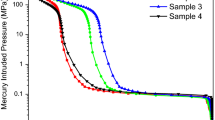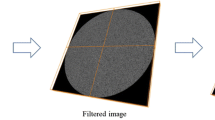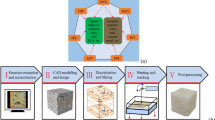Abstract
3D printing with powders offers the most analogous method to the natural way in which clastic reservoir rocks are formed, resulting in pore network textures and morphologies similar to natural rocks. To characterize pore networks and their transport properties in rock proxies 3D-printed from powdered materials, solid proxy reservoir rocks were 3D-printed in aluminum, steel, ceramic, and gypsum powders. These proxies were analyzed using traditional destructive and nondestructive reservoir characterization methods. While CT and helium porosimetry helped identify connected porosity, mercury porosimetry provided information on the pore-throat size distribution. X-ray fluorescence was used to identify elemental composition of each material. Thin-section petrography provided further information on proxy pore network microstructure. Despite designing a solid digital model, 3D printers using powder materials can impart significant porosity as a byproduct of the printing process that can be used for repeatable flow and geomechanical experiments in proxies. Ceramic and aluminum proxies showed the lowest porosity. Gypsum proxies had the highest porosity (36%) and range of porosities (5–36%). Metal proxies (aluminum and steel) showed low porosity and minimal mercury intrusion. Proxies were printed in two sizes (8 mm × 15 mm and 25 mm × 25 mm). Larger proxies were lower in porosity except in the case of gypsum because of post-processing artifacts. Ceramic and gypsum proxies showed significant compressibility at high mercury intrusion pressures. Proxies printed in silica sand were the most analogous to natural reservoir rocks despite their high porosity (36–51%) and pore-throat size mode (70 μm).








Similar content being viewed by others
References
AK Steel: AK Steel 420 Stainless Steel. http://www.aksteel.com/pdf/markets_products/stainless/martensitic/420_data_sheet.pdf (2017)
Bhattacharjee, N., Urrios, A., Kang, S., Folch, A.: The upcoming 3D-printing revolution in microfluidics. Lab Chip 16(10), 1720–1742 (2016). https://doi.org/10.1039/C6LC00163G
Fereshtenejad, S., Song, J.J.: Fundamental study on applicability of powder-based 3D printer for physical modeling in rock mechanics. Rock Mech. Rock Eng. 49, 1–10 (2015). https://doi.org/10.1007/s00603-015-0904-x
Gerami, A., Alzahid, Y., Mostaghimi, P., Kashaninejad, N., Kazemifar, F., Amirian, T., Mosavat, N., Warkiani, M.E., Armstrong, R.T.: Microfluidics for porous systems: fabrication, microscopy and applications. Transp. Porous Media 1–28 (2018). https://doi.org/10.1007/s11242-018-1202-3
Ishutov, S., Fullmer, S.M., Buono, A.S., Hasiuk, F.J., Harding, C., Gray, J.: Resurrection of a reservoir sandstone from tomographic data using 3-D printing. Am. Assoc. Pet. Geol. Bull. 101, 1425–1443 (2017). https://doi.org/10.1306/11111616038
Ishutov, S., Jobe, T.D., Zhang, S., Gonzalez, M.A., Agar, S.M., Hasiuk, F., Watson, F., Geiger, S., Mackay, E., Chalaturnyk, R.: 3D printing for geoscience: fundamental research, education, and applications for the petroleum industry. Am. Assoc. Pet. Geol. Bull. 102, 1–26 (2018). https://doi.org/10.1306/0329171621117056
Karadimitriou, N.K., Hassanizadeh, S.M.: A review of micromodels and their use in two-phase flow studies. Vadose Zone J (2012). https://doi.org/10.2136/vzj2011.0072
Kong, L., Ostadhassan, M., Li, C., Tamimi, N.: Can 3-D printed gypsum samples replicate natural rocks? An experimental study. Rock Mech. Rock Eng. (2018). https://doi.org/10.1007/s00603-018-1520-3
Lucia, F.J.: Carbonate Reservoir Characterization: An Integrated Approach, vol. 7. Springer, Berlin (2007)
Osinga, S., Zambrano-Narvaez, G., Chalaturnyk, R.J.: Study of geomechanical properties of 3D-printed sandstone analogue. In: ARMA Conference, Paper 2015-547 (2015)
Pilliar, R.M., Filiaggi, M.J., Wells, J.D., Grynpas, M.D., Kandel, R.A.: Porous calcium polyphosphate scaffolds for bone substitute applications—in vitro characterization. Biomaterials 22, 963–972 (2001). https://doi.org/10.1016/S0142-9612(00)00261-1
Primkulov, B., Chalaturnyk, J., Chalaturnyk, R., Zambrano Narvaez, G.: 3D Printed sandstone strength: curing of furfuryl alcohol resin-based sandstones. 3D Print. Addit. Manuf. 4(3), 149–156 (2017). https://doi.org/10.1089/3dp.2017.0032
Scholle, P.A., Ulmer-Scholle, D.S.: A color guide to the petrography of carbonate rocks: grains, textures, porosity, diagenesis. AAPG Mem. 77, 333 (2003)
Schröder-Turk, G.E., Mickel, W., Schröter, M., Delaney, G.W., Saadatfar, M., Senden, T.J., Mecke, K., Aste, T.: Disordered spherical bead packs are anisotropic. Europhys. Lett. 90, 34001 (2010). https://doi.org/10.1209/0295-5075/90/34001
Seitz, H., Rieder, W., Irsen, S., Leukers, B., Tille, C.: Three‐dimensional printing of porous ceramic scaffolds for bone tissue engineering. J. Biomed. Mater. Res. B: Appl. Biomater. 74(2), 782−788 (2005)
Shi, J.Q., Durucan, S.: Exponential growth in San Juan Basin Fruitland coalbed permeability with reservoir drawdown: model match and new insights. SPE Reserv. Eval. Eng. 13(06), 914–925 (2010). https://doi.org/10.2118/123206-PA
Song, W., de Haas, T.W., Fadaei, H., Sinton, D.: Chip-off-the-old-rock: the study of reservoir-relevant geological processes with real-rock micromodels. Lab Chip 14, 4382–4390 (2014). https://doi.org/10.1039/c4lc00608a
Song, L., Jiang, Q., Shi, Y.E., Feng, X.T., Li, Y., Su, F., Liu, C.: Feasibility investigation of 3D printing technology for geotechnical physical models: study of tunnels. Rock Mech. Rock Eng. 9, 1–21 (2018). https://doi.org/10.1007/s00603-018-1504-3
Stratasys: Safety Data Sheets for VeroWhite Plus RGD835, SDS-06124. http://global72.stratasys.com/~/media/Main/Files/SDS/Rigid-Opaque-Materials/SDS-Objet-VeroWhitePlus-RGD835-US.pdf, http://www.stratasys.com/3d-printers/design-series/objet260-connex3 (2013)
Tiab, D., Donaldson, E.C.: Petrophysics: Theory and Practice of Measuring Reservoir Rock and Fluid Transport Properties. pp. 106–109. Gulf Professional Publishing (2015)
Zhou, T., Zhu, J.B.: Identification of a suitable 3D printing material for mimicking brittle and hard rocks and its brittleness enhancements. Rock Mech. Rock Eng. (2017). https://doi.org/10.1007/s00603-017-1335-7
Acknowledgements
I would like to thank Sergey Ishutov for executing some of the analytical work for this project as well as thoughtful discussions on interpreting the data. I would like to thank Drs. Rick Chalaturnyk and Bauyrzhan Primkulov (University of Alberta) for 3D printing the silica proxies analyzed in this study. I would like to thank Dr. Michelle Barger, Iowa Department of Transportation, for facilitating the HHXRF analysis. This study was funded in part by Aramco (Grant No. A-0139-2015) Services Company, 16300 Park Row Dr., Houston, TX 77084.
Author information
Authors and Affiliations
Corresponding author
Ethics declarations
Conflict of interest
None.
Additional information
Publisher's Note
Springer Nature remains neutral with regard to jurisdictional claims in published maps and institutional affiliations.
Electronic supplementary material
Below is the link to the electronic supplementary material.
Rights and permissions
About this article
Cite this article
Hasiuk, F.J. Testing Bulk Properties of Powder-Based 3D-Printed Reservoir Rock Proxies. Transp Porous Med 129, 501–520 (2019). https://doi.org/10.1007/s11242-018-1221-0
Received:
Accepted:
Published:
Issue Date:
DOI: https://doi.org/10.1007/s11242-018-1221-0




